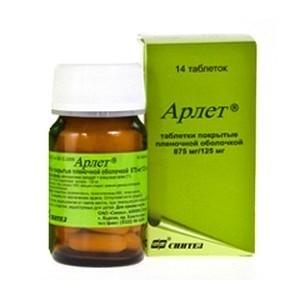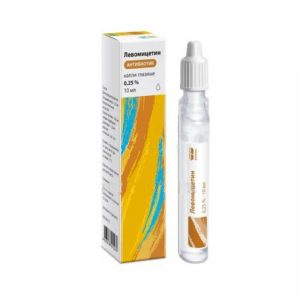Description
Release form
Film-coated tablets.
Packing
14 pcs.
Pharmacological action of
Arlet is a combination of amoxicillin (semisynthetic penicillin with a wide spectrum of antibacterial activity and clavulanic acid (an irreversible inhibitor of -lactamases). Clavulanic acid forms a stable inactivated complex with the indicated enzymes-organisms and microorganism enzymes ° · and microorganism-resistant enzymes
Clavulanic acid, similar in structure to -lactam antibiotics, has a weak intrinsic antibacterial activity.
Arlet has a wide range of antibacterial effects. It is active against strains that are sensitive to amoxicillin, including strains producing β-lactamases: – gram-positive aerobes: Streptococcus pneumoniae, Streptococcus pyogenes, Streptococcus viridans, Streptococcus bovis, Staphylococcus aureus (except methicillin-resistant strains of resistance, ), Staphylococcus saprophyticus, Listeria spp., Enteroccocus spp.
– gram-negative aerobes: Bordetella pertussis, Brucella spp., Campylobacter jejuni, Escherichia coli, Gardnerella vaginalis, Haemophilus influenzae, Haemophilus ducreyi, Klebsiella spp., Moraxella catarrheidissidaereis Ieris neeris Ieris neissa Salmonella spp., Shigella spp., Vibrio cholerae, Yersinia enterocolitica, Helicobacter pylori, Eikenella corrodens
– gram-positive anaerobes: Peptococcus spp., Peptostreptococcus spp., Clostridium spp., Actinomyces psp.
– gram-negative anaerobes: Bacteroides spp.
Indications
Infections caused by susceptible strains of microorganisms:
– infections of the upper respiratory tract and ENT organs (acute and chronic sinusitis, acute and chronic otitis media, pharyngeal abscess, tonsillitis, pharyngitis)
– infections of the lower parts bronchitis with bacterial superinfection, chronic bronchitis, pneumonia)
– urinary tract infection
– infection in gynecology
– skin and soft tissue infection
– bone and connective tissue infection
– infection ii biliary tract (cholecystitis, cholangitis)
– odontogenic infection.
Contraindications
Hypersensitivity (including to cephalosporins and other beta-lactam antibiotics), infectious mononucleosis (including with the appearance of a measles-like rash), children under 3 years old (for this form. form) .
With caution – pregnancy, lactation, severe liver failure, diseases of the gastrointestinal tract (including a history of colitis associated with the use of penicillins), chronic renal failure.
Use during pregnancy and lactation
Arlet can be prescribed – during pregnancy only in those cases when the intended benefit to the mother outweighs the potential risk to the fetus.
Amoxicillin and clavulanic acid in small quantities pass into breast milk, so if you need to use the drug during lactation, you should decide whether to stop breastfeeding.
Special instructions
During the course of treatment, it is necessary to monitor the state of the function of the blood forming organs, liver, and kidneys.
Patients with severe renal impairment require adequate dose adjustment or increased dosing intervals.
In order to reduce the risk of side effects from the gastrointestinal tract, the drug should be taken with meals.
Composition
1 tablet contains amoxicillin trihydrate 825 mg, clavulanic acid 125 mg
excipients: polyvinylpyrrolidone (povidone), talc (magnesium hydrosilicate), starch 1500, calcium stearic acid (calcium stearic acid), calcium stearylate .
shell composition: hypromellose (hydroxypropyl methylcellulose), propylene glycol, titanium dioxide, polyethylene oxide 4000 (macrogol 4000).
Dosage and administration of
Arlet taken orally. Adults and children over 12 years old (or with a body weight> 40 kg) for mild or moderate infections – 1 table. Arlet 500/125 mg every 12 hours, in case of severe infection and respiratory tract infections – 1 table. 500/125 mg every 8 hours
Side effects of the
From the digestive system: loss of appetite, nausea, vomiting, diarrhea rarely – impaired liver function, increased activity of alanine aminotransferase (ALT) or aspartic aminotransferase (ACT) in isolated cases – cholestatic jaundice, hepatitis, colitis, hepatitis.
Allergic reactions: itching, urticaria, erythematous rashes rarely – multiforme exudative erythema, angioedema, anaphylactic shock in isolated cases – exfoliative dermatitis, Stevens-Johnson syndrome.
From the hematopoietic system: a reversible increase in prothrombin time, leukopenia, reversible agranulocytosis and hemolytic anemia.
From the central nervous system: dizziness, headache, reversible hyperactivity and cramps.
From the kidneys and urinary tract: interstitial nephritis, crystalluria.
Other: candidiasis and other types of superinfection.
Drug Interactions
Concomitant use with methotrexate increases the toxicity of methotrexate. The appointment together with allopurinol increases the incidence of exanthema. Antacids, glucosamine, laxatives, aminoglycosides – slow down and decrease absorption. Ascorbic acid increases absorption. Bactericidal antibiotics (including aminoglycosides, cephalosporins, cycloserine, vancomycin, rifampicin) have a synergistic effect, bacteriostatic drugs (macrolides, chloramphenicol, lincosamides, tetracyclines, sulfonamides) are antagonistic. Increases the effectiveness of indirect anticoagulants (suppressing the intestinal microflora, reduces the synthesis of vitamin K and the prothrombin index). With the simultaneous administration of anticoagulants, it is necessary to monitor the indicators of blood coagulability. Reduces the effectiveness of oral contraceptives, drugs, during the metabolism of which para-aminobenzoic acid is formed, ethinyl estradiol – the risk of breakthrough bleeding. Diuretics, allopurinol, phenylbutazone, non-steroidal anti-inflammatory drugs and other drugs that block tubular secretion increase the concentration of amoxicillin (clavulanic acid is excreted mainly by glomerular filtration).
Overdose
In most cases, symptoms of an overdose include disorders of the gastrointestinal tract (abdominal pain, diarrhea, vomiting), anxiety disorders, insomnia, dizziness are also possible, in some cases seizures. At overdose the patient should be under the supervision of a doctor, treatment is symptomatic.
In case of a recent intake (less than 4 hours), gastric lavage and activated charcoal should be performed to reduce suction. Amoxicillin / clavulanate potassium is removed by hemodialysis.
Storage Conditions
In a dry, dark place at a temperature not exceeding 25 ° C. Keep out of reach of children.
Active ingredient
Amoxicillin, Clavulanic acid
Terms leave around drugstore
prescription
PMA pills
Prescription
For adults as prescribed by a doctor, Children as prescribed by a doctor, Children older than 12 years old
Indications
Indications
bronchitis, cholecystitis, urinary tract infections, otitis media, tonsillitis, osteomyelitis, pneumonia, tonsillitis, Skin infection, pharyngitis, sinusitis, periodontal
Synthesis AKOMP, Russia


